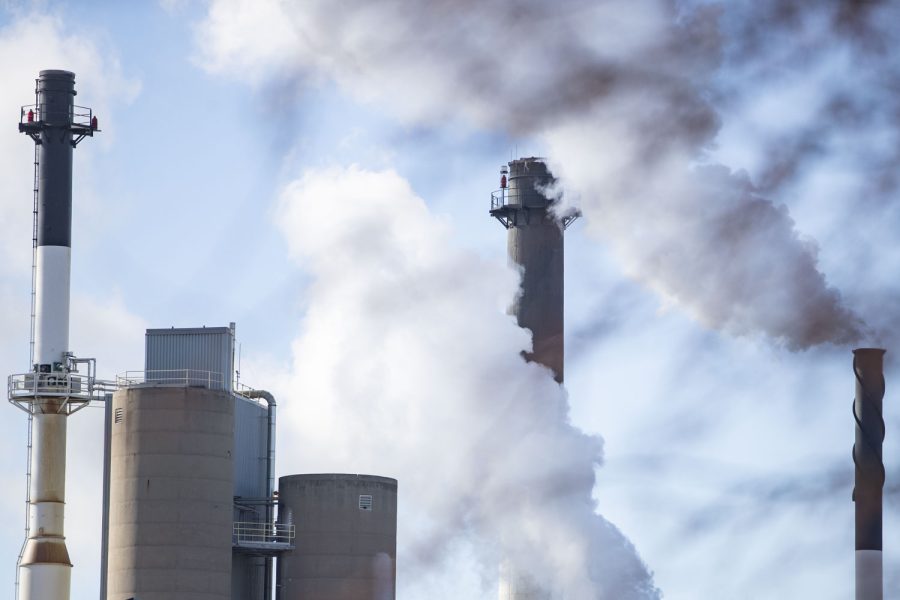Following the release of the 2023 Iowa Climate Statement and record-breaking temperatures that largely impacted Iowa’s air quality, climate experts stress that working toward using more sustainable energy sources is more crucial than ever.
According to the Climate Statement released on Oct. 9, scientists have found that warming temperatures in the atmosphere and ocean can be attributed to greenhouse gases, particularly fossil-fuel combustion.
Peter Thorne, University of Iowa distinguished chair and professor of occupational and environmental health, said greenhouse gases consist of carbon dioxide, methane, and nitrous oxide.
Thorne said these gases are released into the atmosphere primarily through the burning of fossil fuels, oil gas, and natural gas.
The majority of greenhouse gas emissions in Iowa in 2021 were from the agriculture sector, followed by emissions from the residential, commercial, and industrial sectors, and fossil fuel use by power plants, and transportation.
In 2021, the total greenhouse emissions amounted to 126.16 million tons of carbon dioxide, a 5.44 percent increase since 2020, according to the Iowa Department of Natural Resources.
Carbon dioxide accounted for over 66 percent of all greenhouse gas emissions in 2021, making up the largest percentage of emissions in Iowa.
Additionally, coal-generated electricity increased by 56.27 percent from 2020-21.
Fossil fuels are not only bad for the environment, but for individuals’ physical health as well, Thorne said. These fuels cause lung disease, cardiovascular disease, infections, and stunted growth in both lungs and children.
“There is a strong interest, in terms of the nation’s health, to go away from burning fossil fuels,” Thorne said.
As these gases are emitted into the atmosphere and combined with solar radiation, the globe begins to warm, resulting in climate change.
Gene Takle, emeritus professor of agronomy at Iowa State University, said even a single degree Celsius increase of the global average temperature is a huge amount.
Thorne said the major approach to climate change is to mitigate and reduce the release of more greenhouse gases by switching to renewable energy, therefore not contributing to greenhouse gases in the atmosphere.
Examples of renewable energy include solar, wind, geothermal, hydroelectric power, and other energy sources that do not rely on fossil fuels.
“We are fundamentally changing the climate in a way that is dangerous for human health and the infrastructure,” Thorne said.
The UI has also been making efforts to combat greenhouse emission usage in its own power plant. The plant makes hot and chilled water to heat and air condition buildings on campus.
Additionally, the plant buys its electricity from Alliance and Mid-American energy.
In the past, Thorne said, the heating plant has burned coal as its primary source of energy. However, the university is now in a transition away from coal and hopes to use other resources in the coming year.
Iowa produces 58 percent of its electricity from wind, Thorne said, and in addition, the cost of wind energy has decreased significantly and is much safer for human health than fossil fuels.
Solar energy has also started to make its mark on the environment in terms of sustainability and efficiency.
The two primary forms of solar energy are commercial and individual solar. Individual solar is often in people’s homes where solar panels can be installed on roofs and the ground. Once installed, solar panels have an anticipated lifetime of 25 years, Thorne said.
“[Solar] is a relatively inexpensive source of power,” Thorne said. “In terms of solar panels, they are relatively maintenance-free, so it really is the way to go.”
RELATED: Iowa climate experts push for more solar energy
By building an energy system that combines wind and solar together, Thorne said, 100 percent of energy needs could be fulfilled.
“We really have averted quite a lot of fossil fuel emissions as a consequence of wind and solar energy and by combining the two, we will be able to make it practically zero on the electricity side,” Thorne said.
Transportation has also been a major contributing factor as most modern cars on the roads continue to use gasoline or gasoline with ethanol.
The Iowa Department of Natural Resources projects a downward trend of roughly 2 percent by 2040 for greenhouse gas emissions in transportation.
Thorne said the move toward the electric transportation sector will result in a reduction in greenhouse emissions as the vehicles begin to be powered by wind, solar, and hydro energy.



